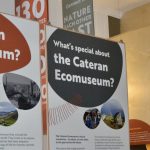Over the last year, we’ve had the privilege of working with the University of the Highlands & Islands in preparing the ground for what we hope will be a wide-ranging programme of archaeology-based activities in the Ecomuseum.
Funded by a UHI Knowledge Exchange and Innovation grant, Dan Lee and Crane Begg (1) and Alex Sanmark and Steven Timoney (2) have created a baseline data set of the heritage and archaeology across the whole 1,000 square kilometres of the Ecomuseum, which aims to support the development of this programme.
In this first blog post, we’ll share what they found about our Scheduled Ancient Monuments, Listed Buildings and Buildings at Risk.

Cateran Ecomuseum study area with CANMORE and Scottish Cultural Protected Sites
Canmore, the online catalogue to Scotland’s archaeology, buildings, industrial and maritime heritage lists 3,305 known sites in the Ecomuseum area, although there is likely to be more! .

Coupar Angus Abbey, photo Markus Stitz
Scheduled Ancient Monuments
There are 136 Scheduled Ancient Monuments (SAM) in the Ecomuseum. SAMs are nationally important sites and areas that have statutory protection, administered by Historic Environment Scotland, with the aim of preserving sites as far as possible. Scheduled areas can be small areas around a specific site or larger areas of landscape containing numerous sites.
The majority of scheduled sites in the Ecomuseum (88%) are prehistoric sites and landscapes, including ritual and funerary monuments (e.g. standing stones, stone circles, cairns, barrows) and defensive and domestic sites (e.g. settlements, enclosures, souterrains, hut circles, round houses and field systems). Most were scheduled in the 1980s and 1990s following the RCAHMS surveys. An example of large area of upland designated as a SAM are the settlements, field systems and cairns at Pitcarmick Estate, which covers an area of approximately 400 hectares. Four ecclesiastical sites have scheduled status, including the abbey precinct and gatehouse at Coupar Angus and Coupar Grange. Other scheduled sites include the Bruceton Farm symbol stone, Cardean Roman fort, Glasclune Castle, Creag Bhreac sheilings and a pill box at Kirkmichael.

Caulfeild Military Bridge at Glenshee, photo George Logan
Listed Buildings
Listed Buildings are designated and administered by Historic Environment Scotland. There are 452 listed buildings in the Ecomuseum. These include 16 buildings that are A-Listed, 219 B-Listed and 217 C-listed. These are too numerous to describe in detail here. Examples of A-listed buildings including the military road bridge at Glenshee and the Haugh of Drimmie suspension bridge, castles (e.g. Newton Castle, large houses (e.g. Keithick House and the War Memorial, Wellmeadow, Blairgowrie).

Oakbank Mill, photo Clare Cooper
Buildings at Risk Register
The Buidings at Risk Register for Scotland is maintained by the Scottish Civic Trust on behalf of Historic Environment Scotland, and provides information on properties of architectural or historic merit (usually in a conservation area) throughout the country that are considered to be at risk from demolition, collapse or disrepair.
Within the Ecomuseum, there are 16 buildings listed on the Buildings at Risk Register for Scotland (13 in Perth and Kinross, 3 in Angus). There are eight buildings at risk in Blairgowrie, including Lornty Mill, Oakbank Mill and Tannage Street warehouse. The cornmill on Bamff Road, Alyth and the Meigle House steading are also at risk. Many buildings registered at risk are also listed buildings.
In our next post about this amazing work by the UHI team, we’ll be sharing what they found out about historical land use in the Ecomuseum.
(1) Orkney Research Centre for Archaeology, UHI Archaeology Institute
(2) Institute for Northern Studies, Perth College UHI

